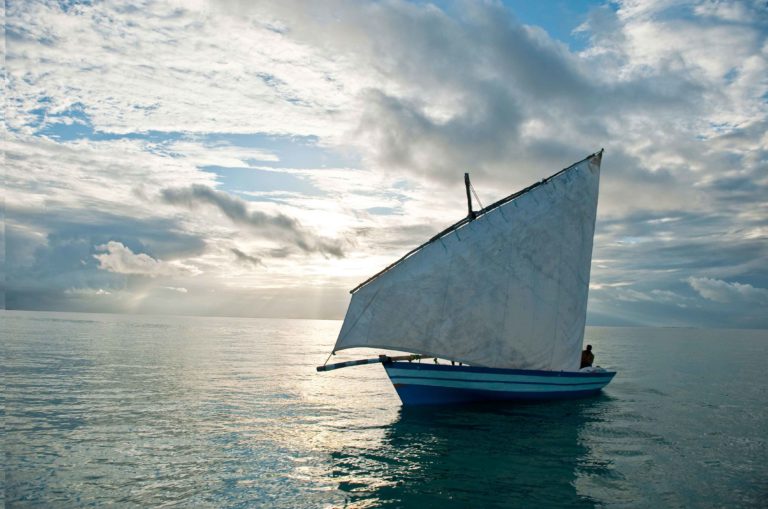I have a weakness for dhows and try to hitch a ride on one whenever I’m in East Africa. Travelling by dhow is addictive. There’s a primitive pleasure in the marriage of wood and canvas with wind and water, the creak of mangrove timbers and coir rope, the cry of commands in Swahili. It’s a very pure form of sailing.

Image: Justin Fox
Propelled by the monsoon winds, dhows from Arabia and India used to bring cargoes of dates, spices and carpets to Africa. When the winds switched direction at the turn of the season, they returned to Asian ports laden with gold, ivory, mangrove poles and slaves. These days, most East African dhows are smaller, coastal descendants of the large oceanic vessels of the past.
Over the years I’ve had the good fortune of sailing dhows of many kinds. My first long voyage was the most memorable. I’d been given the name of a Mr Yussuf, who might be able to help me sail to Lamu, Kenya. After some negotiation I was told to meet him at his shop in Malindi one evening.
‘Mr Justin, this is Yunus,’ said Yussuf. ‘For $120 he will take you all the way to Lamu.’ Yunus Aboud was squint and carried a foot-long dagger. His band of sailors wore khanzu robes and made four threatening figures in the shadows. To be quite honest, I’d been worried about this moment all along. I thought of slavers, pirates, Muslim fundamentalists, the slit of a throat and splash of a body overboard.
‘Meet us on the beach at sunrise,’ said Yunus. We shook hands. I could not see his eyes.
I woke with the warbling call to prayer and was down on the beach before the sun. Yunus stowed my bags in fish-smelling drums amidships. The yardarm was hoisted and lateen sail unfurled to much shouting. Fayswal was a sleek thoroughbred and we were soon creaming northward. ‘Ours is the number-one dhow,’ said Yunus. ‘We win the races every year.’
Past the sandbanks we were into a rolling swell and taking water over the bows. Our helmsman steered with his foot, the crew trimmed the lateen and Yunus set his lures. We sailed past fishing boats at anchor and coral reefs boiling with surf. Eventually we reached a great peninsula jutting into the ocean.
Night fell and the sea grew rougher. A tangerine moon slipped behind a bank of clouds. Ahead was the feeble beam of Lamu’s lighthouse, but without chart or compass it wasn’t much help. Given the spring low tide, there was less than a fathom’s depth over the sandbanks. Surf thundered on either side. The sail flogged as we tried to spill wind and get our bearings.
I looked astern and saw a dark shadow that, to my horror, turned white with a crash. It was an enormous wave. Next thing it felt as though we’d been boxed by a giant fist. Water exploded over the stern. The dhow was given an almighty shove and we shot ahead of the breaker like a cork. If we’d broached just then, Fayswal would have capsized. The dhow slewed hard over as we came off the wave.
Next thing, we were into the calm of Lamu Channel and the crew broke into a Swahili shanty that lifted the hairs on the back of my neck. Ahead of us, we could make out the lights of Lamu harbour. Fayswal ran crisply, propelled by a tropical zephyr into the ancient anchorage. Wherever I looked, dhows of every shape and size lay anchored. It felt as though we were coasting through a dream time before the advent of steam and propeller.
It was thus with delight that I received an email from Carinè Müller, who was about to embark on a most unusual voyage from Lamu to Zanzibar on a plastic dhow. Read about her adventure and its powerful message concerning ocean pollution. Similarly, Erlo and Lauren Brown’s astonishing hike from Cape Agulhas to the Angola border had, as one of its aims, making people aware of the plastic soiling our shores.
May you have an equally adventurous July!
Image: Justin Fox
You may also like
Related Posts
Justin Fox talks climate change, 50 years of Earth Day and how to live a...
read more
When visiting popular tourist spots nowadays, you can’t help but encounter the selfie stick. These...
read more
Justin Fox expounds on the sublime beauty of the Drakensberg, reflecting on pilgrims past and...
read more